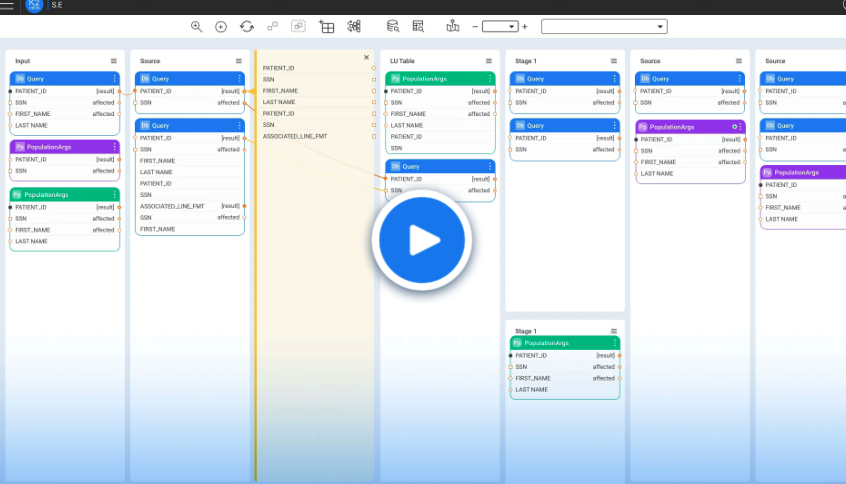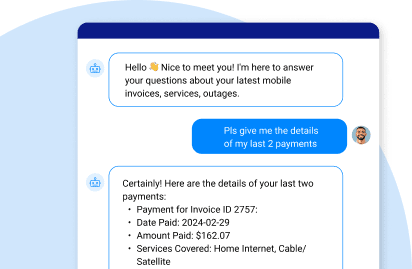Supercharge conversational AI with Retrieval-Augmented Generation (RAG) for responses that are as complete, compliant, and current as your enterprise data.
Conversational AI defined
Conversational AI is a branch of Generative AI (GenAI) that enables machines to simulate conversation with humans. It combines two critical technologies:
- Natural Language Processing (NLP) helps GenAI applications understand the intent and meaning behind human language.
- Machine Learning (ML) allows these applications to continually learn, adapt, and improve over time. .
By training on massive volumes of text and speech data, a conversational AI platform learns to recognize communication patterns and respond in a way that feels natural – driving everything from a customer service chatbot to an AI virtual assistant.
Retrieval-augmented generation defined
While conversational AI makes it possible for machines to interact like humans, Retrieval-Augmented Generation (RAG) solves a critical challenge: Keeping those interactions accurate, relevant, and informed by the latest knowledge. RAG integrates a retrieval mechanism into the generation process, enabling Large Language Models (LLMs) to pull information from fresh, trusted data sources – such as enterprise systems and knowledge bases – just as they’re crafting a response.
Here’s how it works: LLMs are trained on huge datasets, but this data quickly becomes outdated. RAG supplements the LLM by retrieving relevant, up-to-date information from trusted enterprise sources. When a user asks a question, RAG finds the best supporting data and combines it with the user’s query. The result is an enhanced prompt fed to the LLM, ensuring the generated response leverages both its broad language training and the most current facts.
RAG brings 3 main advantages to the conversational AI table:
- Timeliness
RAG gives LLMs live access to the latest information. - Relevance
RAG improves the quality and context of responses. - Robustness
RAG enables AI to tackle complex, niche, or unexpected questions with greater confidence.
In a recent survey of 300 AI professionals across industries, we found that momentum is building: 12% already have RAG-enhanced conversational AI in production, 60% are piloting, 24% are planning, and 4% are exploring.

Status of RAG conversational AI adoption
Source: K2view State of Enterprise Data Readiness for GenAI in 2024 report
How does RAG enhance conversational AI?
When paired with conversational AI, RAG dramatically improves the relevance, personalization, and trustworthiness of responses. Instead of relying solely on pre-trained data, a conversational AI platform powered by RAG can access real-time insights from across the enterprise. This means:
- A customer service chatbot becomes a totally up-to-date know-it-all that can retrieve details from CRM systems or past tickets to answer customer inquiries more precisely.
- Educators and tutors using conversational AI can personalize lessons by incorporating individual student performance data pulled dynamically through RAG.
- Conversational AI in healthcare can safely consult medical databases to provide the latest, evidence-backed responses to patient questions.
RAG also solves the persistent problem of stale data. Without it, conversational AI might base answers on outdated or incomplete information. With RAG, AI systems continuously retrieve fresh data from internal and external sources, ensuring conversations reflect the latest product launches, customer interactions, or market shifts.
Beyond keeping information current, RAG also supports hyper personalization. For instance, a conversational AI for customer service can leverage RAG to pull up a client’s purchase history in real time, then make tailored recommendations or resolve specific issues.
Perhaps most critically, RAG helps conversational AI handle open-ended or unexpected questions. Even if a user asks about an unfamiliar product or a complex topic, the system can search for relevant knowledge on the fly – greatly expanding its ability to respond informatively and maintain a natural, helpful dialogue.
Key use cases for conversational AI with RAG
Adding RAG conversational AI is changing how we interact with technology and businesses in many fields, notably:
-
Conversational AI chatbots powered by RAG act as tireless, 24/7 AI virtual assistants – handling common questions, troubleshooting problems, and even scheduling appointments – all while drawing on the latest customer data to personalize every interaction. With GenAI dealing with basic queries, human agents can concentrate on more complex cases.
-
Sales and marketing
Conversational AI enhances the customer journey by answering detailed product questions, suggesting items based on past purchases, and qualifying leads – all informed by data retrieved through RAG. This capability not only boosts conversion rates but also generates valuable insights for future campaigns.
-
Education and training
Conversational AI tutors can dynamically adapt lessons based on each student’s history. Using RAG to pull relevant academic data, they deliver personalized feedback, answer nuanced questions, and adjust their teaching style to individual needs.
-
Healthcare
A conversational AI platform, augmented by RAG, can guide patients through symptom checks, manage appointment scheduling, and provide medication reminders. By retrieving up-to-date clinical information, they enhance care quality and patient confidence.
-
Employee assistance
Conversational AI can serve as a smart HR aide – guiding employees through onboarding, answering policy questions, or managing leave requests. With RAG, HR virtual assistants stay informed by pulling the latest data from internal HR systems .
Challenges conversational AI still faces
Even with the power of RAG, conversational AI has hurdles to overcome on its path to maturity:
-
Natural Language Understanding (NLU)
Grasping human nuances like sarcasm or slang is still a major challenge.
-
Handling surprises
Open-ended or out-of-scope questions can stump AI systems that lack robust retrieval capabilities .
-
Keeping the dialogue flowing
Poorly designed conversational flows or repetitive answers can frustrate users.
-
Bias
Training data may include biases that surface in outputs .
-
Cost
Building and maintaining advanced conversational AI requires significant investment.
-
Data freshness
Without mechanisms like RAG, conversational AI can fall behind, relying on stale data or missing access to real-time customer and product information .
The role of data products in RAG conversational AI
To maximize the impact of RAG in conversational AI, many organizations turn to reusable data products. Think of these as highly organized, ready-to-query collections of enterprise data – like perfectly indexed filing cabinets that make it easy for RAG systems to find exactly what they need.
Unlike static documents, data products draw from live systems to present a unified, current view of the customer, product, or any other key business entity. As conversational AI processes a user query, these data products feed fresh context directly into the LLM, enabling more accurate, relevant, and tailored responses.
For example, the K2View Data Product Platform gives conversational AI secure API, CDC, messaging, or streaming access to unified data across multiple systems, enabling it to:
- Resolve customer issues faster.
- Run hyper-personalized marketing campaigns.
- Offer intelligent cross-sell and upsell suggestions.
- Detect fraud by spotting suspicious patterns in real time.
The K2view AI chatbot for customer service is the ultimate solution for RAG-powered conversational AI – integrating disparate enterprise info into dynamic data products that supercharge GenAI apps with fresh, actionable intelligence.
Discover how the K2view AI chatbot for customer service
solution integrates enterprise RAG with conversational AI.













